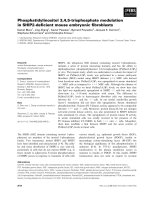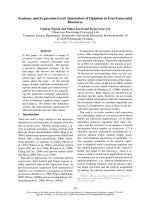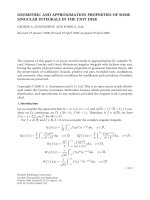btec level 5 hnd diploma in computing unit 16 cloud computing
Bạn đang xem bản rút gọn của tài liệu. Xem và tải ngay bản đầy đủ của tài liệu tại đây (8.16 MB, 60 trang )
<span class="text_page_counter">Trang 1</span><div class="page_container" data-page="1">
<b> ASSIGNMENT 1 FRONT SHEET </b>
</div><span class="text_page_counter">Trang 3</span><div class="page_container" data-page="3"><b> </b>
<b>Summative Feedback: </b><b> </b>
<b>Resubmission Feedback:</b><b>Internal Verifier’s Comments:</b>
</div><span class="text_page_counter">Trang 4</span><div class="page_container" data-page="4"><b>Signature & Date:</b>
</div><span class="text_page_counter">Trang 5</span><div class="page_container" data-page="5">Table of Contents
<b>I. Introduction ... 5 </b>
<b>II. Overview cloud computing... 5 </b>
<b>III. Client and server ... 6 </b>
<b>1.Client</b> ... 7
<b>2.Server</b> ... 7
<b>3. Relation between Client and Server ... 8 </b>
<b>IV.Peer- -peerto</b> ... 9
<b>V. High Performance Computing... </b>10
<b>1. Definition and benefit ... </b>10
</div><span class="text_page_counter">Trang 7</span><div class="page_container" data-page="7"><b>IX. Virtualization and Multicore ... </b>22
</div><span class="text_page_counter">Trang 9</span><div class="page_container" data-page="9"><b>I. Introduction </b>
Teenagers may purchase toys from ATN, a Vietnamese company, in many locations all around Vietnam. The company brings in more than $700,000 annually. At the moment, each store maintains a database that keeps track of transactions unique to that store. Every business is expected to provide monthly sales data to the board director, and it takes a lot of time for the board director to compile all of the data. In addition, the board is unable to see the stock information change in real time. I will examine the history and core ideas of cloud computing in this assignment's first task. In assignment 2, I will first create and describe the architecture diagram for a particular situation. The deployment model will then be defined, followed by a description of its advantages. In order to select an appropriate model for a certain case, I will examine the service models before discussing the programming language, web server, and database server that were selected.
<b>II. Overview cloud computing </b>
Delivering various services through the Internet is known as cloud computing. These tools and programs comprise software, servers, databases, networking, and data storage, among other things. For both individuals and companies, it is a popular choice because to a number of benefits, including lower costs, more productivity, speed and efficiency, performance, and security. Because the information being accessed is located remotely in the cloud or another virtual space, cloud computing derives its name. Customers of cloud service providers can store documents and software on distant servers and then access it online. This suggests that access to it does not need that the user be present there, enabling remote work. Cloud computing removes all of the labor-intensive data processing and crunching from the device you use while working or carrying around. Additionally, it transfers all of that work to massive computer clusters located online. Your data, work, and apps are accessible from any device that can connect to the Internet, from anywhere in the world, as the Internet transforms into the cloud. (techxcorp, 2022)
</div><span class="text_page_counter">Trang 11</span><div class="page_container" data-page="11">Figure 1 Cloud Computing :
<b>III. Client and server </b>
In the development of computerized systems, the client/server paradigm is used. The foundation of this idea is the division of tasks into the two classes of independent and autonomous processors known as servers and clients. A client is any process that requests specific services from a server process. A server is a method for providing customers with the services they have requested. The same computer or different computers connected by a network can run both client and server processes. (madooei, 2022)
</div><span class="text_page_counter">Trang 12</span><div class="page_container" data-page="12">Figure 2: Client erver /S
</div><span class="text_page_counter">Trang 13</span><div class="page_container" data-page="13">The four different client types can be described as follows:
➢ Thick client: The majority of resources and data processing are handled by thick clients. These clients seldom use the server; the majority of their work is done locally instead.
➢ Thin client: These resource-conserving clients mostly rely on a server to handle all of the data and provide them with resources.
➢ Hybrid client: Thin and thick clients can be combined to create hybrid clients. This type of client keeps permanent data on a server while processing data locally. ➢ Zero clients: Zero clients are more affordable and thinner than thin clients. These
client devices have no data and don't need any settings. They also use less energy than thick or thin clients.
<b>2. Server </b>
</div><span class="text_page_counter">Trang 14</span><div class="page_container" data-page="14">A computer program or apparatus that offers a service to another program and its user, often known as the client, is referred to as a server. The actual machine that a server application runs on in a data center is also commonly referred to as a server. It's possible the device serves as a dedicated server or serves other functions. A server program responds to requests from client programs, which may be operating on the same computer or on other machines, under the client/server programming model. Depending on the application, a computer may act as both a client and a server to other programs requesting services from it. (techtarget, 2022)
</div><span class="text_page_counter">Trang 15</span><div class="page_container" data-page="15">Figure 3: Server Some types of servers:
• Web server: a program on a computer that delivers requested HTML files or pages. The client in this instance is a web browser.
• Application server: software that serves as the business logic for an application program that operates on a computer connected to a distributed network.
• Mail server: a program that forwards outgoing emails for delivery and receives incoming emails from both local and remote senders.
• File server: computer that is responsible for centrally maintaining and storing data files so that other computers
• Database server: This server is responsible for managing one or more databases. Database
</div><span class="text_page_counter">Trang 16</span><div class="page_container" data-page="16">queries are executed by client programs to read data from or write data to the database hosted by the server.
<b>3. Relation between Client and Server </b>
In a client-server connection, one computer, referred to as the client, requests services from another, referred to as the server. A client-server model's primary characteristic is that the client is reliant on the server to deliver and handle the information. Websites, for instance, are kept on web servers. (teachcomputerscience, 2022)
</div><span class="text_page_counter">Trang 17</span><div class="page_container" data-page="17">Figure 4: Relation between Client and Server
<b>IV. Peer-to-peer </b>
Peer-to-peer refers to a category of systems and applications that use dispersed resources to carry out a task without the use of a central authority. The resources include processing speed, content storage, network bandwidth, and presence (computers, humans, and other resources). Distributed computing, data/content sharing, communication, teamwork, or platform services can all play a crucial role. Any combination of algorithms, data, and meta-data may be subject to decentralization. This does not prohibit keeping some of the systems and applications centrally
</div><span class="text_page_counter">Trang 18</span><div class="page_container" data-page="18">p p g y pp ymanaged. P2P systems often exist on ad hoc networks or at the Internet's periphery. (vietnix, 2022)
</div><span class="text_page_counter">Trang 19</span><div class="page_container" data-page="19">Figure 5: Peer- -peer to
<b>P2P Example: </b>
Torrent:Each machine participating in torrent has an internet connection. Any file on the network can be uploaded by one computer, at which point other computers can begin downloading the file. Additionally, if a computer has previously downloaded some of the file, it might upload portions of the file.
A computer connected to a local area network (LAN): Computers can form peer- -topeer networks and share data and resources at home or in a small workplace.
<b>V. High Performance Computing </b>
</div><span class="text_page_counter">Trang 20</span><div class="page_container" data-page="20"><b>1. Definition and benefit </b>
High-performance computing (HPC) is the technique of processing data in parallel to increase computer speed and carry out complicated computations. HPC accomplishes these objectives by pooling computing resources, allowing even sophisticated programs to function effectively, dependably, and promptly in accordance with user demands and expectations. As a result, it performs better and uses significantly more power than conventional workstations, servers, and PCs. (techtarget, 2022)
The benefit of HPC:
</div><span class="text_page_counter">Trang 21</span><div class="page_container" data-page="21">• High speed: Since HPC systems are designed for lightning-fast processing, they should be able to complete a significant number of computations in record time. Contrarily, doing the same calculations might take days, weeks, or even months on conventional processors and computer systems.
• Lower cost: Applications run more fast and provide results more quickly on an HPC system because it can process data more quickly, saving time and money. Many of these systems may also be scaled up or down as necessary and are available in "pay as you go" modes, which further increases their cost-effectiveness.
• Reduced need for physical testing: Before they can be made available for use by the general public or businesses, many contemporary applications must undergo extensive physical testing. Application researchers, developers, and testers can create complex simulations with HPC 12 systems, reducing or even doing away with the need for expensive or time-consuming physical testing.
<b>2. Parallels </b>
Running a program or computation simultaneously on many processors is known as parallel computing. Generally speaking, it is a style of computing architecture where large problems are split up into independent, smaller, often related components that may be processed in a single step. Multiple CPUs collaborate by using shared memory, and the finished products are then combined. By spreading the big issue among numerous computers, it facilitates large calculations. (heavy, 2022)
</div><span class="text_page_counter">Trang 22</span><div class="page_container" data-page="22">Figure 6: parallel computing
</div><span class="text_page_counter">Trang 23</span><div class="page_container" data-page="23">The benefits of parallel computing:
• Bit-level parallelism: expands the word size of the processor, reducing the number of instructions required to perform an operation on variables longer than the word.
• The software technique uses static parallelism, in which the compiler chooses which instructions to execute in parallel, whereas the hardware approach uses dynamic parallelism, in which the processor picks which instructions to execute in parallel at runtime.
• Task parallelism is a technique for spreading computer code over numerous processors so that various tasks can be carried out simultaneously on the same data.
• Superword-level parallelism is a vectorization method that can take use of inline code parallelism.
<b>3. Cluster </b>
A group of closely or ad hoc connected computers that cooperate to perform tasks as a single unit is known as a cluster. The connected computers perform tasks collectively, giving the appearance of a single system. Fast local area networks typically connect the clusters (LANs) (esds, 2022)
</div><span class="text_page_counter">Trang 25</span><div class="page_container" data-page="25">Figure 7: Cluster computing
Advantages of cluster computing:
• High Performance: The systems perform better than mainframe computer networks. • Simple to handle: Cluster computing is simple to deploy and manage.
• Scalable: As a result, the clusters' resources may be increased.
• Expandability: By adding more computers to the network, computer clusters may easily grow. Multiple resources or networks can be merged with the current computer system thanks to cluster computing.
• Availability: When one node fails, the other nodes take over and function as the failed node's substitutes. This guarantees more accessibility.
• Flexibility: More nodes may be added or it can be modified to a higher standard.
</div><span class="text_page_counter">Trang 27</span><div class="page_container" data-page="27">Figure 8: Distributed computing
An architecture for a distributed cloud has several advantages. These are cited by Gartner as being noteworthy:
• Increased compliance: Workloads and data can be located where they need to be to meet regulatory requirements because they are distributed by nature. • Increased uptime Since cloud services can reside on local subnets, they can :
be isolated even untethered from the main cloud when needed to ensure – –they are isolated from a crashed system to provide redundancy.
• Scalability:By adding virtual machines (VMs) or nodes as needed, the cloud system may scale quickly while also enhancing its overall availability. • Flexibility:Distributed clouds make it easier to deploy, install, and test new
services.
• Faster processing: By using the computational power of numerous computers for a certain job, distributed systems can operate more quickly. Additionally, for particular locations, the dispersed cloud provides more. • Performance: The distributed cloud can offer higher performance and better
cost performance than centralized computer network clusters.
<b>VI. Deployment models </b>
The type of cloud environment based on ownership, scalability, and access, as well as the nature and purpose of the cloud, are specified by the cloud deployment model. The many cloud computing deployment models include:
</div><span class="text_page_counter">Trang 28</span><div class="page_container" data-page="28">• Public cloud • Private cloud • Hybrid cloud • Community cloud
</div><span class="text_page_counter">Trang 29</span><div class="page_container" data-page="29">Figure 9: Deployment Models
<b>1. Public Deployment </b>
The term "public cloud" describes online computing services provided by independent vendors. The public cloud's services, in contrast to private clouds, can be used or purchased by anybody. These services may be offered for free or on a pay-per-use basis, with customers only paying
</div><span class="text_page_counter">Trang 30</span><div class="page_container" data-page="30">for the CPU time, storage space, or bandwidth that they actually use. A cloud service provider, whose products and services are accessible online, manages a public cloud. By providing scalability and flexibility, public clouds effectively meet the collaborative needs of today's global workforce, providing significant business value to businesses. (techtarget, 2022)
There are several advantages and disadvantages of a public cloud. • Advantage:
➢ The cloud does not require maintenance. ➢ There is no restriction on the quantity of users. ➢ The public cloud can grow very quickly.
➢ A cloud can be put up without any infrastructure being established.
</div><span class="text_page_counter">Trang 31</span><div class="page_container" data-page="31">➢ Compared to other cloud models, they are less expensive. ➢ Strict SLAs are adhered to.
• Disadvantage:
➢ There is a security issue.
➢ Organizational autonomy and privacy are impossible.
<b>2. Private Deployment </b>
The National Institute of Standards and Technology (NIST) defines a private cloud as cloud infrastructure that is made available solely for usage by a single business that includes several users. It may exist on or off premises and be owned, managed, and operated by the organization, a third party, or some combination of them. Simply said, a private cloud is a cloud environment designed for a single enterprise. Although it can be maintained by the organization or any other third party, it is typically private to the organization. Open- urce tools like OpenStack soand Eucalyptus may be used to deploy a private cloud. When compared to other cloud types, the private cloud is compact. Here, the enterprises themselves deploy and operate the cloud. (nvlpubs, 2022)
A private cloud has a number of benefits and drawbacks: • Advantage:
➢ It is within the organization's management.
➢ It offers the user a high level of protection and privacy. ➢ The cloud is manageable and tiny in size.
• Disadvantage:
➢ The private cloud faces financial limitations. ➢ The SLAs for private clouds are lax.
</div><span class="text_page_counter">Trang 32</span><div class="page_container" data-page="32"><b>3. Community Cloud </b>
NIST defines the community cloud as the cloud infrastructure that is set aside for the sole use of a particular community of users from businesses that have similar concerns regarding their purpose, security needs, policies, and compliance requirements. It may exist on or off-premises and be owned, managed, and administered by one or more community groups, a third party, or some combination of them. (nvlpubs, 2022)
</div><span class="text_page_counter">Trang 33</span><div class="page_container" data-page="33">The community cloud has a number of benefits and drawbacks, including: • Advantage:
➢ enables the creation of a cheap private cloud. ➢ superior security compared to public clouds. ➢ enables cloud collaboration for work.
➢ allows for responsibility sharing throughout the company. • Disadvantage:
➢ An organization loses its autonomy. ➢ The private cloud has better security features. ➢ If there is no teamwork, it is not appropriate.
<b>4. Hybrid Cloud </b>
According to NIST, a hybrid cloud is an infrastructure that combines two or more different clouds (private, communal, or public), each of which remains a separate legal entity, but which are connected by standardized or proprietary technology that facilitates data and application mobility. The typical approach to adopting a hybrid cloud is to start with a private cloud and subsequently use a public cloud for more resources. (nvlpubs, 2022)
Both hybrid clouds' benefits and drawbacks include: • Advantage:
➢ having access to both public and private clouds. ➢ superior security compared to public clouds. ➢ extremely scalable
• Disadvantage:
➢ The security features fall short of the public cloud in quality. ➢ A hybrid cloud is difficult to manage.
</div>








